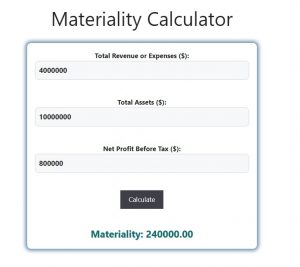About Materiality Calculator (Formula)
In the realm of financial reporting and auditing, materiality refers to the significance of an amount, transaction, or discrepancy in influencing the decisions of users of financial statements. Understanding materiality is essential for auditors, accountants, and financial analysts, as it guides the evaluation of whether certain financial information is relevant and should be disclosed. The Materiality Calculator simplifies the process of determining materiality thresholds based on a company’s financial metrics, helping ensure that all stakeholders receive accurate and pertinent information.
Formula
The formula to calculate materiality is:
Materiality = 0.0075 * Total Revenue or Expenses + 0.015 * Total Assets + 0.075 * Net Profit Before Tax
Where:
- Total Revenue or Expenses: The total amount of income or costs incurred by the company.
- Total Assets: The cumulative value of all assets owned by the company.
- Net Profit Before Tax: The profit earned by the company before tax deductions.
How to Use
To effectively use the Materiality Calculator, follow these steps:
- Collect Financial Data: Obtain the required financial metrics from the company’s balance sheet and income statement, including total revenue or expenses, total assets, and net profit before tax.
- Input Values: Enter these financial figures into the calculator.
- Calculate Materiality: The calculator will apply the formula and compute the materiality threshold.
- Assess Findings: Compare the calculated materiality amount against any discrepancies in the financial statements to determine if they are significant enough to warrant attention.
Example
Consider a company with the following financial figures:
- Total Revenue: $4,000,000
- Total Assets: $10,000,000
- Net Profit Before Tax: $800,000
To calculate materiality:
- Calculate each component:
- Materiality from Revenue: 0.0075 * $4,000,000 = $30,000
- Materiality from Assets: 0.015 * $10,000,000 = $150,000
- Materiality from Net Profit: 0.075 * $800,000 = $60,000
- Sum the results:
- Total Materiality = $30,000 + $150,000 + $60,000 = $240,000
Thus, the materiality threshold for this company is $240,000. Any misstatements or omissions under this amount may be considered immaterial in the context of the financial statements.

FAQs
- What does materiality mean in auditing?
- Materiality refers to the importance of financial information, where omissions or misstatements could influence the economic decisions of users.
- Why is materiality important?
- It helps auditors and financial professionals determine what financial information is relevant and needs to be disclosed.
- How is materiality determined?
- Materiality is determined using specific formulas that incorporate key financial metrics such as revenue, assets, and net profit.
- What are the components of the materiality formula?
- The formula includes total revenue or expenses, total assets, and net profit before tax.
- Can materiality thresholds vary by industry?
- Yes, different industries may have varying thresholds based on risk, regulatory requirements, and financial practices.
- What happens if a misstatement exceeds the materiality threshold?
- If a misstatement exceeds the materiality threshold, it is typically reported and addressed in the financial statements.
- Is materiality a fixed figure?
- No, materiality can change based on the financial context and the nature of transactions or events.
- How often should materiality be recalculated?
- Materiality should be recalculated regularly, especially during audits or when there are significant changes in financial performance.
- What is the difference between qualitative and quantitative materiality?
- Quantitative materiality focuses on numerical thresholds, while qualitative materiality considers the nature and context of information beyond just numbers.
- Can internal auditors use the Materiality Calculator?
- Yes, internal auditors can use the calculator to assess materiality in their reviews of financial statements.
- What is the impact of materiality on financial reporting?
- Materiality ensures that only significant information is reported, enhancing the clarity and relevance of financial statements.
- How does the materiality threshold affect decision-making?
- A well-defined materiality threshold guides stakeholders in making informed decisions based on relevant financial data.
- What are common practices for establishing materiality?
- Practices include benchmarking against industry standards, historical performance, and risk assessments.
- Does materiality apply to all financial statements?
- Yes, materiality applies to all financial statements, including balance sheets, income statements, and cash flow statements.
- How can technology assist in calculating materiality?
- Financial software and calculators can automate materiality calculations, improving accuracy and efficiency.
- What should be done if materiality is not properly assessed?
- Failure to assess materiality can lead to misleading financial reports and potential legal ramifications for the company.
- What role does professional judgment play in materiality?
- Professional judgment is essential in determining materiality, as it considers the specific context and nuances of financial data.
- Can materiality levels differ between audits?
- Yes, materiality levels may vary between audits based on the scope, objectives, and specific circumstances of the audit.
- How does materiality relate to fraud detection?
- Understanding materiality helps auditors focus on areas where discrepancies may indicate potential fraud or misrepresentation.
- What is a common mistake when calculating materiality?
- A common mistake is failing to consider all relevant financial metrics, leading to an inaccurate assessment.
Conclusion
The Materiality Calculator is a valuable tool for professionals in finance and auditing, providing a systematic approach to determining materiality thresholds. By understanding and applying the materiality formula, stakeholders can ensure that financial statements are accurate, relevant, and useful for decision-making. Regular assessments of materiality not only enhance financial reporting but also build trust with stakeholders and regulatory bodies.
